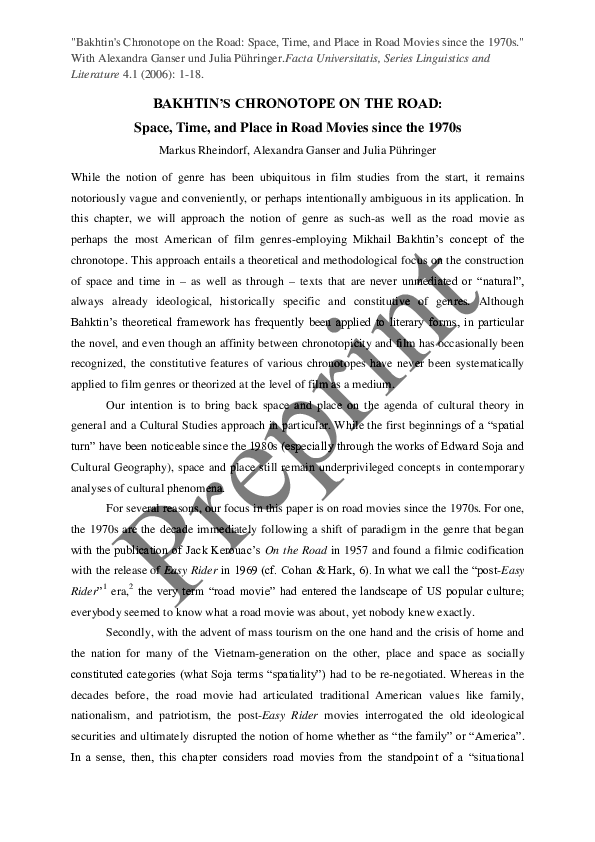
The next Chronotope is the Biography (1700-1950), the praise of a public figure who has accomplished something in life. Together the papers in this volume explore the implications of Bakhtin’s concept of the chronotope for a variety of theoretical topics such as literary imagination, polysystem theory and literary adaptation for modern views on literary history ranging from the hellenistic romance to nineteenth-century realism and for analyses of well-known novelists and poets as diverse as Milton, Fielding, Dickinson, Dostoevsky, Papadiamandis and DeLillo. Western Culture starts his quest to control Nature and eventually the World. McNaughton elegantly summarizes it in his journal article (thus saving me a bit of trouble), Bakhtin came up with the concept of the ‘chronotope’ (the ‘time/space’), which he defined as ‘the intrinsic interconnectedness of temporal and spatial’ elements in a novel. Western Culture starts his quest to control Nature and eventually the World. It is also the time of the Great Explorations (Columbus) of the world outside the West. These thematic categories contain contributions by well-established Bakhtin specialists such as Gary Saul Morson and Michael Holquist, as well as a number of essays by scholars who have published on this subject before. Bakhtin was a Russian philosopher and literary critic. The Bible is translated in the language of the people.

After an extensive introduction that serves as a ‘state of the art’, the volume is divided into four main parts: Philosophical Reflections, Relevance of the Chronotope for Literary History, Chronotopical Readings and Some Perspectives for Literary Theory. Key words: Bakhtin, chronotope, road, nature poetry, American novel, Robert Frost, Jack Kerouac, poetic interconnection. After 1917 revolution, he published a great deal of his own writing on literary, Sociological and Linguistic area. He was a professor, Social critic and friend of Mikhail Bakhtin. This concept, initially developed in the 1930s and used as a frame of reference throughout Bakhtin’s own writings, has been highly influential in literary studies. The Object, Task and Methods of Literary History - P.N.Medvedev and M.M. In some cases they will be expanded into longer entries as the Literary Encyclopedia evolves.This edited volume is the first scholarly tome exclusively dedicated to Mikhail Bakhtin’s theory of the literary chronotope. First published 18 July 2001 187 Chronotope 2 Historical context notes are intended to give basic and preliminary information on a topic.
#Bakhtin chronotope of the quest how to#
For more information on how to subscribe as an individual user, please see under Individual Subcriptions.ĭentith, Simon. (BRANDO, 2013, p.95).8 It is Bakhtins search for human transformations that allows. You are not a member of a subscribing institution, you will need to purchase a personal Forms of Time and of the Chronotope in the Novel. Offer, or via your institution's remote access facilities, or by creating a personal user account with your institutional email address. Institution ( see List), you should be able to access the LE onĬampus directly (without the need to log in), and off-campus either via the institutional log in we

In the final essay, he discusses literature and language in general, which he sees as stratified, constantly changing systems of subgenres, dialects, and fragmented 'languages' in battle with one another. Top from the AbeBooks Marketplace. The genre of the medieval quest (one of Bakhtin’s primary examples) is distinguished by the chronotope of the road, which depicts time protracted over the length of a journey, while the domestic drama of the nineteenth century novel is dependent.

#Bakhtin chronotope of the quest series#
If you are a member (student of staff) of a subscribing Two essays, 'Epic and Novel' and 'Forms of Time and of the Chronotope in the Novel,' deal with literary history in Bakhtins own unorthodox way. : Bakhtin and his Others: (Inter)subjectivity, Chronotope, Dialogism (Anthem Series on. For Bakhtin, literary genres are unequivocally connected to the sites in which they depict time.


 0 kommentar(er)
0 kommentar(er)
